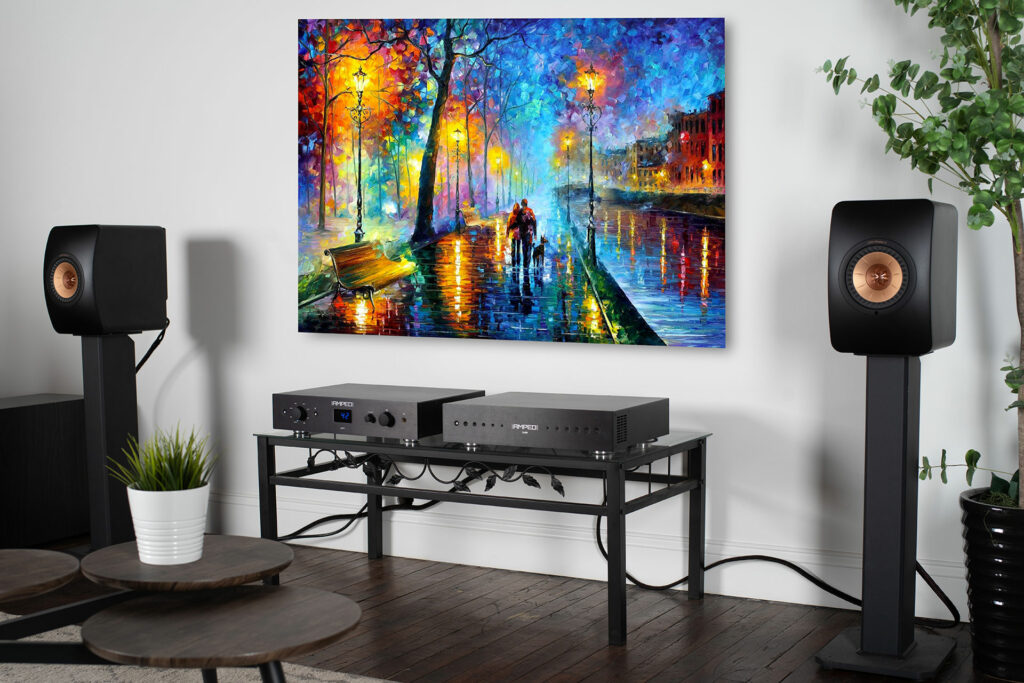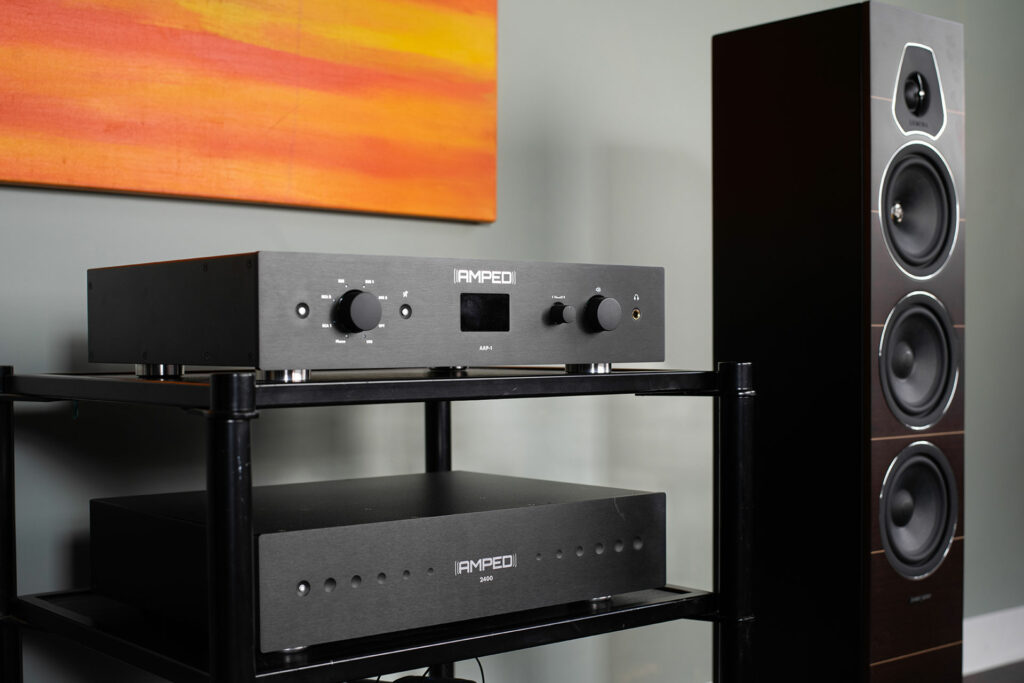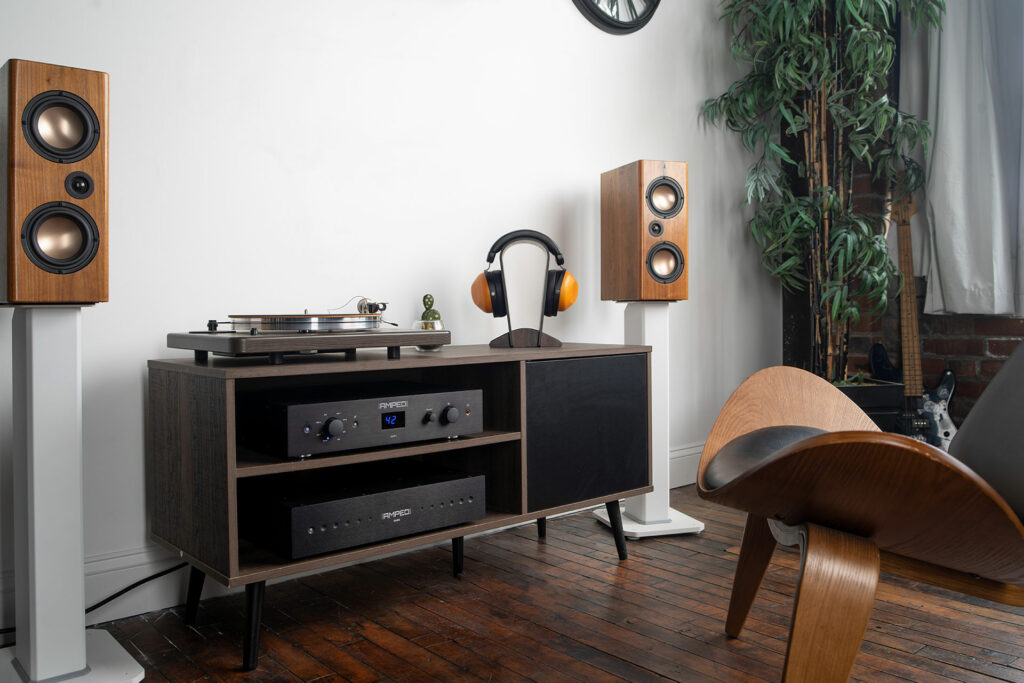We’ve been pretty psyched here at Future Audiophile about Amped America’s presence on the audiophile astral plain. What’s not to love? The company’s affordable Class D amplifiers like the AMP 2400 utilize the same core technologies as amplifiers costing six times as much. Amped America also provides its take on what an affordable yet high-performance preamplifier should be in the form of the AAP-1.
Today’s preamplifiers need to be flexible like a Kung Fu master, while cognizant of the notion that each feature put into a preamplifier potentially detracts from the sound of said component, or at least the fear among some potential customers that this may be the case. A preamp’s core function is typically to provide volume control and source switching. Today’s preamps can also have HDMI inputs, Bluetooth connectivity, room correction, bass management, 32-bit upconverting digital-to-anal converters, advanced phono sections, and even more.

For $3,000, can the Amped America AAP-1 offer up a high-performance DAC, a nifty phono stage, and headphone amplifier without sacrificing core? That’s what we’re here to find out.
What Makes the Amped America AAP-1 Preamplifier Special?
- The AMPED AAP-1 features the company’s High Efficiency Power Supply (HEPS) technology. Power supplies are the foundation that the sonic performance of any audio gear is built upon, especially amplifiers, but even preamps. Amped America’s HEPS can deliver very high power and low noise crucial for audiophile-grade performance.
- The AMPED AAP-1 uses technology known as Audiophile Ultra Sonic Performance (AUSP). AUSP is based around the company’s proprietary Class D circuitry and allows the AAP-1 to provide sonic performance on par with much more expensive preamps in the market. The magic of AUSP is found in a digital power supply (a combination, really, of digital and analog). The result is very stable, clean DC voltage to PCB board, which makes for a more efficient and specifically quiet stereo preamp.
- The DAC in the AMPED AAP-1 comes with a wide array of inputs, offering excellent flexibility. The chip is from Bravo and is of the 32-bit upscaling variety.
- Both the phono stage and the headphone amplifier are exceptionally high performance in ways that most wouldn’t expect in a $3,000 stereo preamplifier. I am not sure that it would be even remotely possible to replace these built-in features with higher performing stand-alone equipment without spending as much as the Amped America AAP-1 itself, if not a little more. The headphone amp and phono stage under the hood of the AAP-1are just that good.
- The understated look of the AMPED AAP-1 has a quality, retro appeal. It is also nice that the small, meaningful display is readable across the room if you want it to be on, and I often do.
- A remote IR input and 12 Volt DC trigger makes integrating the Amped America AAP-1 into a closet audio rack possible.
- The AMPED AAP-1 has enough thoughtful connectivity to integrate into just about any audiophile system. Two analog RCA ins, a heck of a phono stage, and balanced inputs allow access to the best feature of the AAP-1, the preamplifier section. In systems that have smaller loudspeakers and require a subwoofer, the dedicated stereo subwoofer output prevents signal from being stolen from the main outputs and preserves fidelity. There is also a fully balanced output.

Why Should You Care About the Amped America AAP-1 Preamplifier?
The AAP-1 is a well-designed stereo preamp, DAC, phono section, headphone amp, volume control, and audiophile source switcher that punches well above its weight class yet is priced at an aspirational level that many in the hobby can actually dream of affording.

Some Things You Might Not Like About the Amped America AAP-1 Preamplifier
- The DAC in the AAP-1 is very good but not world-class. The internal audiophile DAC will decode just about anything one can throw at it, except for MQA (now pretty much defunct). Sonically, it is just not as much of a value as the rest of the features built into the AAP-1. Perhaps the headphone amp and the phono section spoiled me, but it wouldn’t be crazy to use a higher-end external DAC with an Amped America AAP-1 when growing your system into its best self somewhere down the road.
- In terms of an innovative feature set, the AAP-1 doesn’t check every box as some others are trying to do. It lacks HDMI inputs, built-in streaming, home theater bypass, networking, room correction, Bluetooth 5.4 (or higher), and bass management. Most of these features are typically packed into preamplifiers and a growing number of integrated amps at this price point and sometimes even lower. This preamp gets a lot done, but it doesn’t deliver on every possible feature in the marketplace today as its focus is more on sound than a laundry list of features.
- The retro look of the Amped America AAP-1 is trendy in the audiophile world right now but some AV enthusiasts like a more modern design flair.
- Like many preamps at this price point, the remote control leaves quite a bit to be desired. I do not care what a remote looks like as long as it is laid out well so I can find the volume buttons and input buttons with ease, and the AAP-1’s remote control certainly fits that bill. But when I pick up the remote control, I sometimes need to do a double check that it is not the remote control for the LED lights in my room because they are identical in shape, size, and both are made of plastic. I wouldn’t mind an optional (sold-separately) remote that is backlit, made of titanium, and worthy of being part of the user experience of such a bad-ass preamp. I don’t want to see the retail price go up as much as perhaps an option for those who care or want to add onto their investment.
Listening to the Amped America AAP-1 Stereo Preamp…
I may have let the cat out of the bag a little early here, but when speaking about the Amped America AAP-1 strictly as a preamplifier, it’s as close to a transparent window into the music as one can get for any reasonable price. The AAP-1’s sonic performance easily dethrones one of my favorite value preamplifiers, the Parasound Halo P6; it has less coloration and more audible dynamics than the significantly more expensive AGD Productions Alto (review pending) and needs a preamplifier like the $12,500 Bricasti M20 or the DAC-less and more bare-bones $6,100 Pass Labs XP-12 to definitively beat it in sonic performance. The result is a strong value proposition when framing the Amped America AAP-1 in terms of raw performance.
I found the phono stage easily outperformed that of the very affordable and relatively recently reviewed Schiit Mani as well as the integrated phono stage of the Parasound Halo P6 (read the review). The AAP-1 had more detail and impact than the Schiit, and was more of a window into the recording than the Parasound. I did feel the phono stage may have had more performance to offer; however, I was reaching its limits with my modest $600 Rega P1 turntable. Listening through Grado SR-80 headphones, the Amped America AAP-1 was dead neutral and had a surprising amount of body in a headphone that can be a little lean without enough power.
How did the Amped America AAP-1 fare on the grand stage of my listening space? To answer that question, it is important to note I used the AAP-1 with a few different amplifiers. First was the Amped America AMP 2400 amp. Next was the AGD Tempo di GaN Gallium Nitride semiconductor based Class-D amplifier. Finally, my Bricasti M30 mono amplifiers were connected for a true test of how the AAP-1 would do in a more insanely high-priced system.
The common theme, regardless of the amplifier, was that the AAP-1 imparts very little coloration to the music and has a low-enough noise floor to preserve fine details that are usually only heard at higher price points. The primary loudspeakers used in testing were the $12,000 PSB Synchrony T-800 speaker (read the review) but Tekton Design Pendragon models were tested, as were more modest Sonus faber Sonetto V floorstanding speakers that are more in-line with the retail price of the AAP-1.
My girlfriend had a music-loving millennial over and the evening spilled into my listening space. I like when this happens because it can help me find music that may have been an anthem of sorts for a generation that I am unfamiliar with. “#SELFIE” by the DJ duo known as The Chainsmokers is a certified platinum track from 2014 that features a narcissistic girl in a club ranting about Instagram popularity, club culture, and the importance of her selfies while obsessing over some guy. Digital music is fun because it is engineered instead of played, and typically very dynamic. This heart-pounding track is no exception. The AAP-1 preserved all the space and texture, and sorted out the rapid-fire voice track over beat in such a way that it put a smile on my face and got my head nodding.
Despite the AAP-1’s window-like view into the music, the treble never had any excessive brightness, nor did the mid-bass have excessive bloom or bloat, even at night-club volumes. When using the DAC in the Amped America AAP-1, I noticed there was dynamic information and overall resolution left out that I was able to re-introduce with the Bricasti Design M1 Series II (read the review) and the Benchmark DAC3 HGC DACs (read the review).
Switching to the theme of “only audiophiles listen to this stuff,” the 2023 track “The Mountain” by Jaime Branch is a hokey-folky, heckin’ good recording that has enthusiastically made my short list of reference recordings. I am a sucker for good, fun, and often wholesome folk music. Though I would never use this as a demo at an audio show, its worthy of a listen on a chill evening for its understandable, light-hearted nature and stellar recording quality.
The track starts with a solo double bass, which then turns plucky while Branche’s crystal clear but tired-sounding vocals are anchored in the soundstage. There is female harmony through the chorus and their interaction is highly entertaining. In an unexpected turn, there is a very quiet rustling in the soundstage and a solo, muted trumpet lights up the music. The AAP-1 was simply phenomenal in resolving every intricacy of this track. The only thing missing when compared to my reference Bricasti Design M20 was a subtle but extremely important sense of height to the recording that made me feel as if I were actually in the auditorium where this track where it was being recorded. Otherwise, I did get the feeling I was about five rows back, centerstage from the musical event. To create this experience, the Amped America AAP-1 had to resolve a lot of audio subtlety. Some of the best details include the bow across the strings of the double bass as well as the intentionally sloppy plucking at times, as well as the breathy and tired aspect of the staccato vocals that provided a sense of exhaustion from climbing the mountain, and a sense of the auditorium as the true-to-instrument trumpet walks around the soundstage. The Amped America AAP-1 preserved all these details with window-like neutral tonality.
Does the Amped America AAP-1 Have Any Resale Value?
The AAP-1 is exactly what I look for in the used market when I am shopping for audio gear personally. I look for items that are from up-and-coming manufacturers that someone is silly enough to dump off because they feel the need for better. Much of the time, they are just rolling through different shades of good equipment, and it comes at the cost of losing diamonds in the rough like this one. Until Amped America becomes a larger audiophile name (which I think will be in the next few years), the AAP-1 will likely get a little lost in the mix of more feature-packed or well-marketed preamplifiers.

Who Is the Competition for the Amped America AAP-1 Preamplifier?
- The Anthem STR preamplifier is an extremely strong contender weighing in at $4,300. It has an extremely capable internal DAC, room correction, bass management, and a flurry of other features that puts a lot of advanced technical control in the user’s hands. I would still choose the Amped America AAP-1 if it yielded superior preamplifier-only performance. This is mainly because that is what I am interested in; however, I would to audition them back-to-back to make this assessment.
- The Rotel RC-1590MKII (buy at Crutchfield) for $2,299, and like the Anthem STR, it offers a lot of feature-packed innovation built around a strong DAC section. The RC-1590MKII also has an advanced Bluetooth functionality, and offers MQA decoding for what that’s worth today. The Amped America AAP-1finds competition here because the flexibility and $700 lower price point can be very appealing to many audiophiles where space constraint and flexibility outweigh raw performance.

Final Thoughts on the Amped America AAP-1 Preamplifier
The $3,000 Amped America AAP-1 preamplifier has shown that using modern technology to perfect the signal path that preserves the highest fidelity possible is a strong alternative to leveraging technology to pack abundant functionality into a preamplifier. The AAP-1 offers sonic performance far exceeding its dream-worthy price point that allows future migration to higher quality source components thanks to its stellar job at the preamplification level while maintaining a thoughtful smattering of functionality.
This is precisely where the AAP-1 shows its specific value. It is for audiophiles who want to climb the audio mountain but have a limited budget to do so, and as such need to get as much high-fidelity based milage out of each component as possible. If you fall into this bucket, ignore that Amped America isn’t an audiophile household name and get one into your actual house for a demo. You won’t be disappointed. Not at all.



